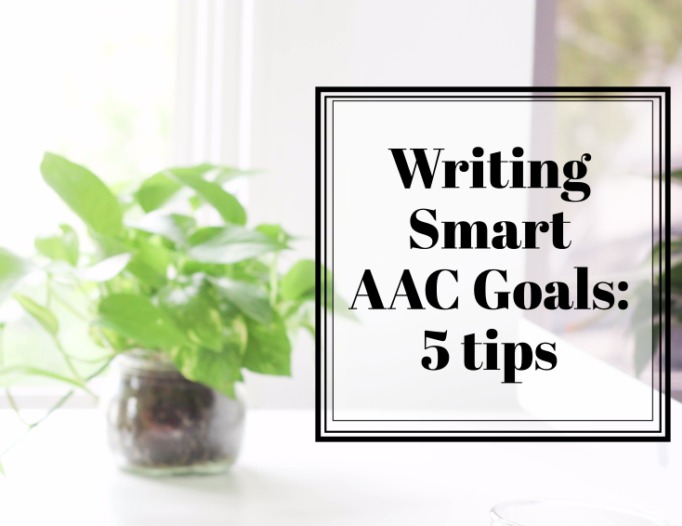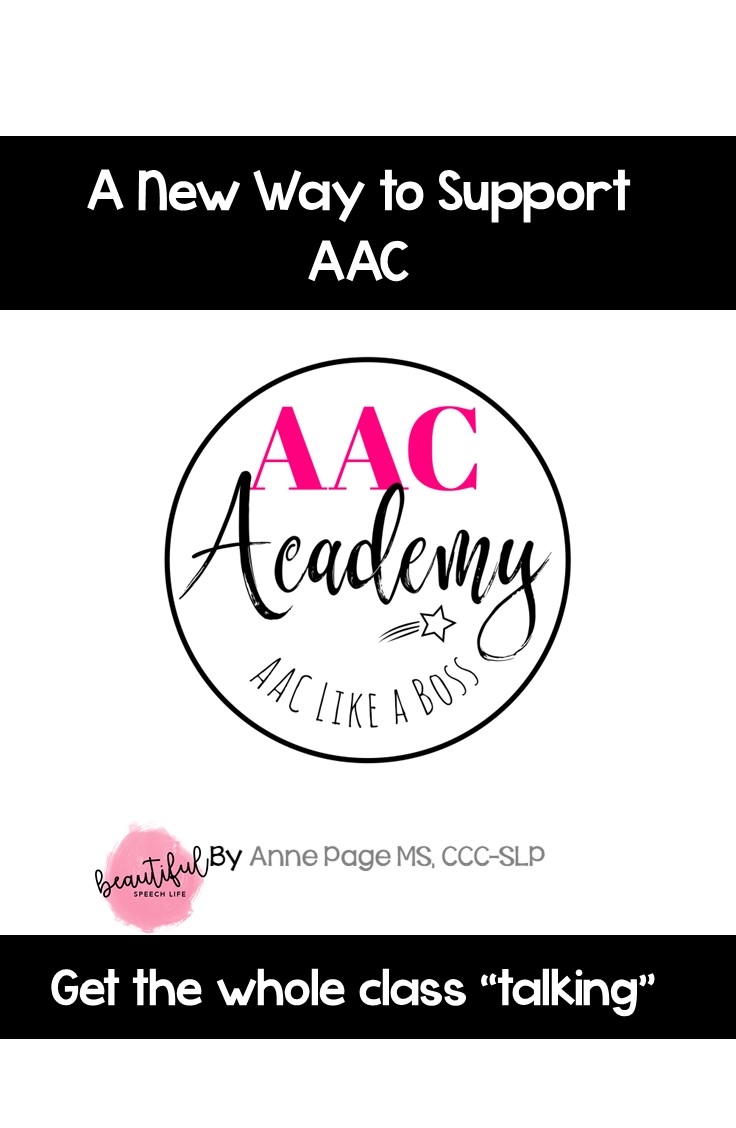Do you get a little scared when you are writing AAC goals in the IEP?
As in, you’re just not quite sure how to word the goal, let alone make it smart? Don’t worry, you’re not alone.
It’s easy to get a little overwhelmed and stuck here. I’ve been there. I remember the first time a teacher said ” Oh by the way, Johnny has this talker device thingy in his backpack, what do we do with it?” I knew we had to push buttons to make it talk but honestly that was about it.
When I thought of writing goals and how to include the device, I was really lost.
So now, a few years later, I’ve figured a few things out and done a lot of investigating when it comes to AAC in the IEP. It’s really not a black and white area but here’s how I do it.
Tip #1: Don’t be scared! It’s mostly just language. You’re an expert in language, (remember you’ve got a master’s degree). You’ve got this.
Don’t freak out about the AAC part. Just focus on what you want your student to communicate. Then look at the how. Look across all areas of language not just labeling. If you get stuck, a helpful tool is Communication Matrix (I’ll include a link at the end of this post). You can use it not only for assessment but also for looking at the areas of language use for emerging and beginning communicators. These are: refuse, obtain, social and information with detailed information on the hierarchy of each.
Here’s an example situation:
Currently when Johnny wants an item he points to it and/or physically takes an adult and to the item. We want his next step to be using core vocabulary words (verbally and/or through AAC use) to obtain a wanted item.
Sample goal from Kate Ahern that I really like:
“Given his communication system of 9-12 core words and ongoing aided language stimulation across the school day Johnny will communicate for three different purposes (such as greeting, commenting, requesting, labeling, asking and answering questions) during a 20 minute group activity with no more than two indirect verbal cues (hints).”
Also you can refer to 1988 Janice Light et al who wrote of four competencies for AAC users: Linguistic, Operational, Social, and Strategic. Kate Ahern lists good examples of these in the linked article below.
Tip #2 An AAC goal still needs to be SMART. (A S.M.A.R.T. goal is defined as one that is specific, measurable, achievable, results-focused, and timebound). You’ll be including time frame, conditions (modeling, cuing, prompting), measurement, assessment and baseline; just like you do in your other goals.
Tip #3 Check to make sure you know your district and state’s procedures and requirements. They aren’t all the same. Talk with your lead SLP, Assistive Technology Consultant, School Psychologist or Special Education Director to make sure you’re including all the required information. Find out where your district wants you to document the type of AAC a student is receiving. It could be listed in the goal OR it might be in the Supplementary Aids and Services section of the IEP.
Tip #4 Document the type of AAC equipment, software or low tech AAC in general descriptive terms. You don’t want to name the specific devices because then you’ll be out of compliance if you’re not using that specific piece of equipment. Think about all the times devices are left at home, aren’t charged and even are broken. You want to make sure you have access to an alternate (such as a laminated photo copy of the main screen on a speech generating device). Here are some suggested terms:
Try this: Communication system including coreboard, choice board, and fringe vocabulary
Instead of: Boardmaker, Lessonpix, etc.
Try this: portable speech generating device
Instead of: Ipad
Try this: dynamic speech generating touch screen device
Instead of: Accent 1400
Tip #5 In the IEP present level section explain why your student needs AAC in school and how your student uses AAC. Here’s an example:
“Johnny uses an augmentative alternative communication (AAC) system to request and to comment. Johnny’s AAC includes a 40 symbol core communication board, 6-8 symbol choice boards and a 10-12 symbol comment board. He is using this system in a variety of settings. This AAC system impacts his progress in the general education curriculum because it allows him to participate in class discussions and activities. This allows for assessment of what he knows. “
Then, of course, you’ll include all the rest of your information on goals and progress.
So there you have it, I hope you found this useful. To sum it up your 5 tips to Writing Smart AAC Goals in the IEP are:
- Don’t be scared-it’s just language.
- Remember an AAC goal still needs to be specific, measurable, achievable, results-focused and time-bound.
- Check for district & state procedures/requirements.
- Document the type of AAC in general descriptive terms.
- Back up your goals in the present level by stating why your student needs AAC and how it impacts his progress in general education.
I have to say this is just a quick summary to get you thinking. As always, use your clinical judgement, do your research and reach out to other SLPs.
Here are links to helpful articles I’ve found:
Kate Ahern’s Meaningful and evidence based goals: here.
Gail Van Tatenhove’s AAC in the IEP: here.
Lauren Ender’s Writing Goals for AAC Users: here.
The Communication Matrix: here.
My Three Tips to AAC Like a Boss for Beginners: here
My BIG Core Vocabulary Board: here.
If this is information overload, just bookmark these, so you’ll have them when you need them.
All right let’s all go AAC LIke a Boss,



 Hey there I’m Anne Page. I help heart centered SLPs and educators put the fun in functional communication.
Hey there I’m Anne Page. I help heart centered SLPs and educators put the fun in functional communication. 